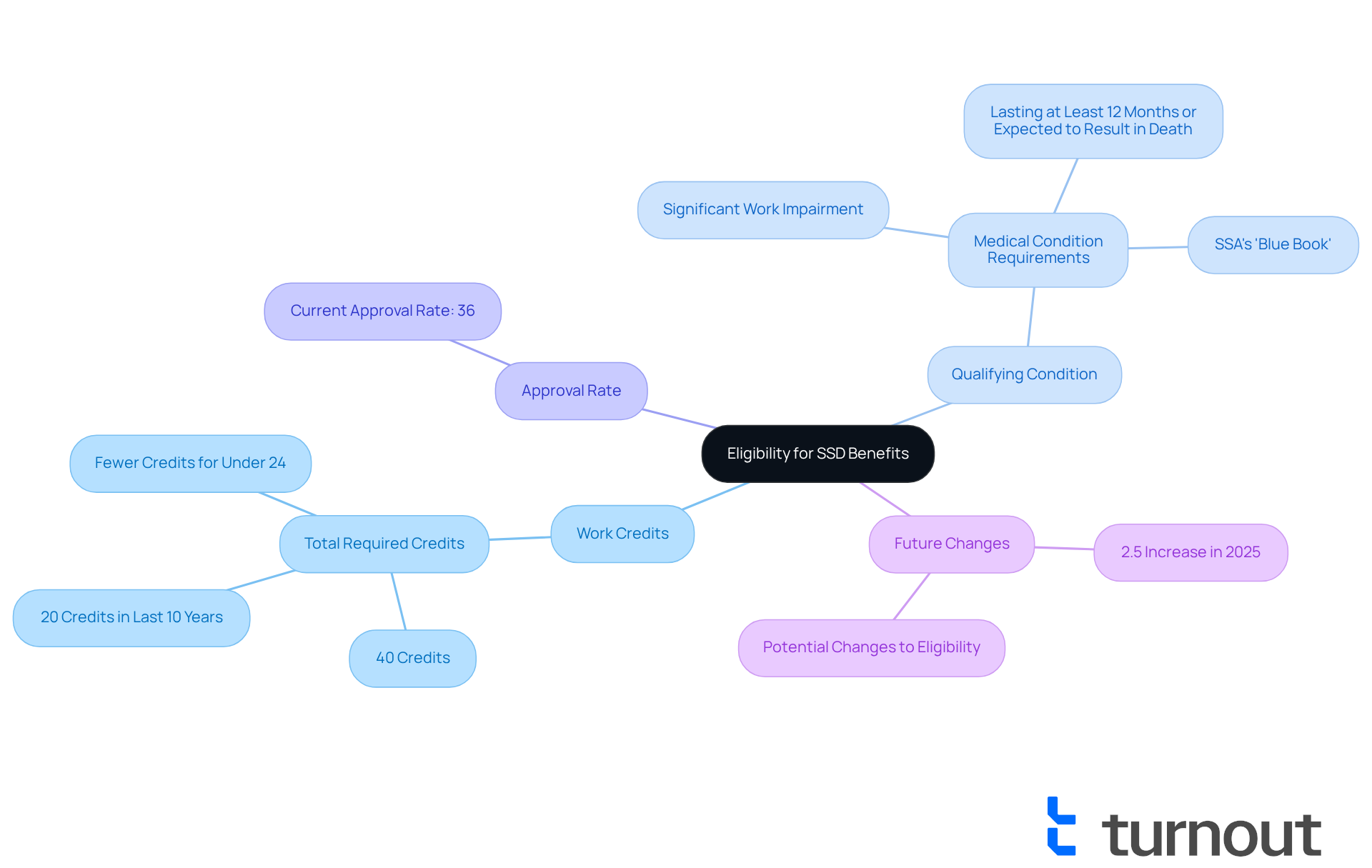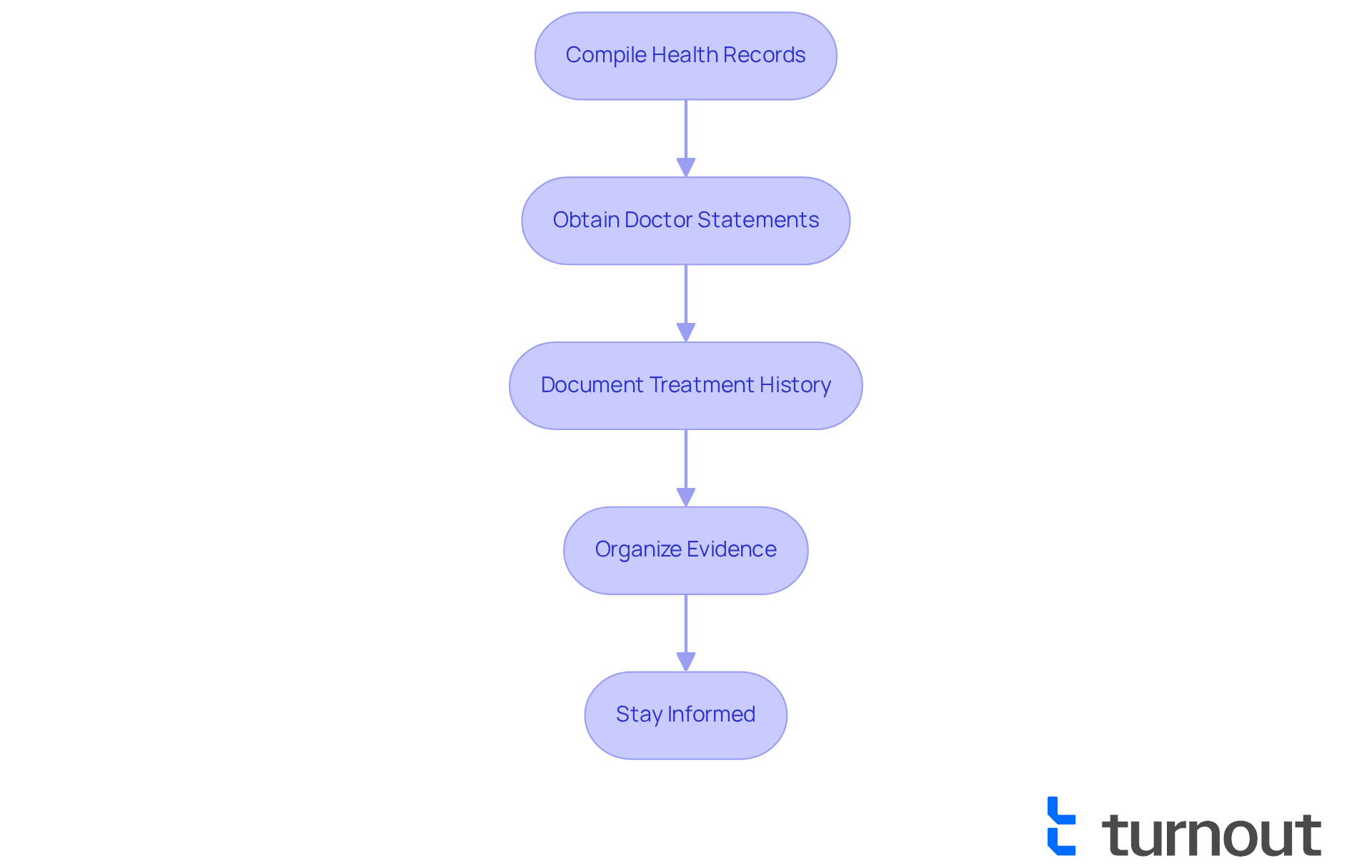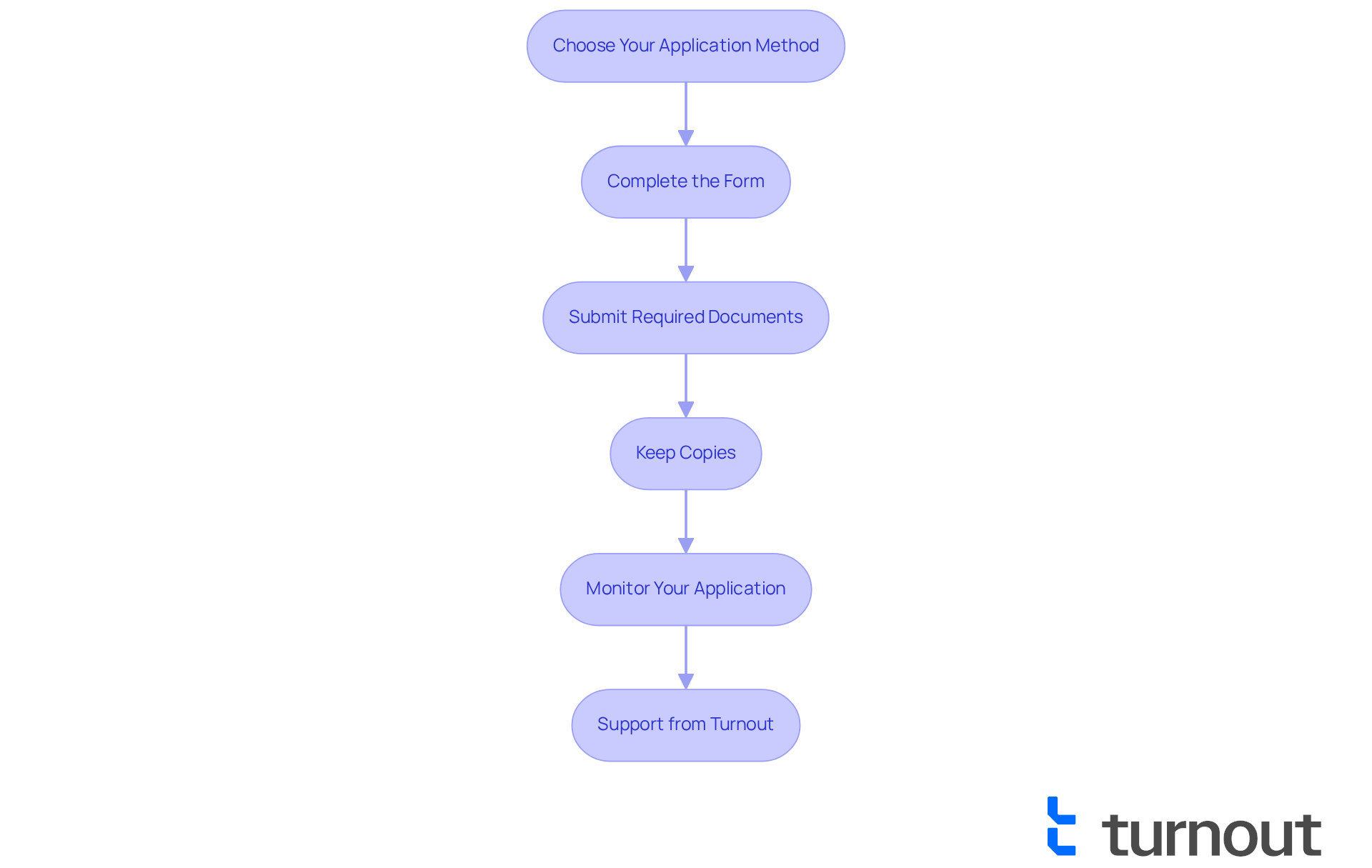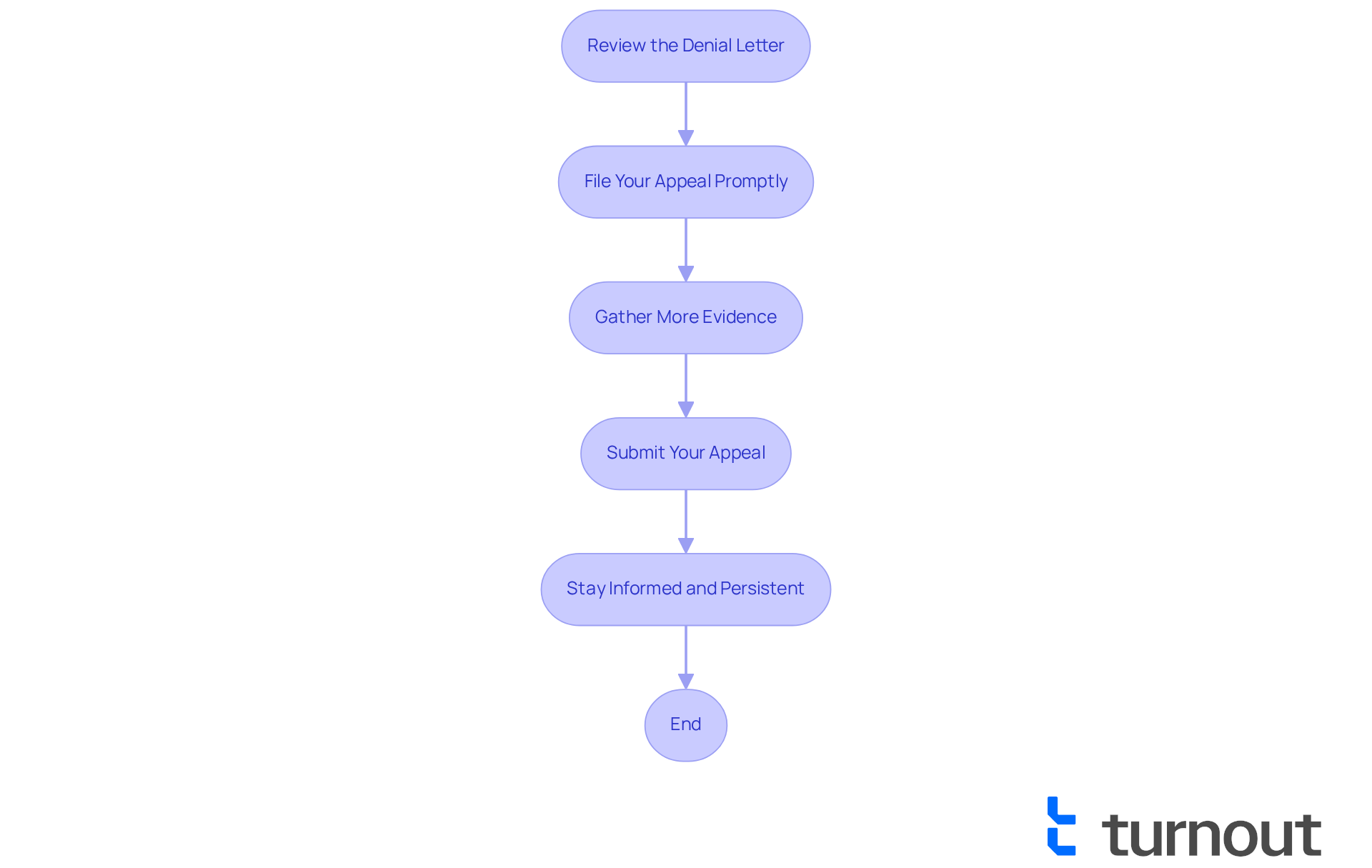Overview
Navigating the process of filing for Social Security Disability (SSD) benefits can feel overwhelming. We understand that many face challenges in determining eligibility and gathering the necessary medical evidence. That's why we've outlined five critical steps to help you through this journey.
- First, it's essential to determine your eligibility. Knowing if you qualify can ease some of the stress.
- Next, gathering medical evidence is crucial. This documentation supports your claim and strengthens your application.
- Once you have your evidence, completing the application is the next step. It’s common to feel anxious during this phase, but remember, you’re not alone.
- After submitting your application, you’ll need to await the decision. This waiting period can be tough, but staying informed can help ease your worries.
- Finally, understanding the appeal process for any denials is vital. If your application is denied, don’t lose hope. There are options available to you.
Each step is supported by detailed guidance on requirements, documentation needed, and procedural timelines. We’re here to help you feel well-informed and prepared throughout the filing process. You deserve support on this journey.
Introduction
Navigating the complexities of Social Security Disability (SSD) benefits can feel overwhelming, especially for those facing health challenges. We understand that understanding the eligibility criteria and the necessary steps to file a successful application is crucial for securing the financial support you need during these tough times.
With changes on the horizon for 2025 that may impact the application process, it’s common to feel uncertain about how to prepare. What strategies can help ensure a smoother journey through the SSD application maze? How can you effectively tackle the potential hurdles along the way?
You're not alone in this journey. Many individuals share your concerns, and there are ways to navigate this process with confidence. Let's explore some supportive strategies together.
Determine Your Eligibility for SSD Benefits
Navigating the path to filing for SSD benefits can feel overwhelming, but understanding the requirements is the first step toward securing the support you need. To qualify, applicants must meet two essential criteria:
-
Work Credits: You need to have contributed to the Social Security system through your employment. Typically, this means accumulating 40 work credits, with at least 20 earned within the last 10 years. If you’re under 24, you might qualify with fewer credits.
-
Qualifying Condition: A medical condition must significantly hinder your ability to work, lasting at least 12 months or expected to result in death. The SSA's 'Blue Book' offers a comprehensive list of qualifying conditions.
We understand that the process can be daunting, especially with recent discussions suggesting that changes in 2025 may simplify assessments for applicants, particularly those facing mental health challenges or invisible disabilities. It's important to note that around 36% of applicants met the work credit requirements last year, indicating a slight decline in approval rates.
Additionally, SSD benefits are set to increase by 2.5% in 2025 due to a cost-of-living adjustment (COLA). This adjustment can make a significant difference for applicants. If you’re wondering how this impacts your claims, Turnout can provide valuable insights. However, be aware that the SSA's proposed changes may affect eligibility for hundreds of thousands of Americans, making it crucial to stay informed.
For a thorough assessment of your eligibility for filing for SSD, consider using the SSA's online tools or reaching out to Turnout's trained nonlawyer advocates. They can help clarify your specific situation and effectively guide you through the process of filing for SSD claims. Remember, Turnout is not a law firm, and the information provided here does not constitute legal advice. You are not alone in this journey; we’re here to help.

Gather Necessary Medical Evidence
Collecting the right health-related evidence is essential for filing for SSD application. We understand that this process can feel overwhelming, but following these steps can help you navigate it more easily:
-
Compile Health Records: Start by gathering all relevant health records, including diagnoses, treatment histories, and test results. Make sure these documents are current and comprehensive. The Social Security Administration (SSA) typically requires health evidence from the past 90 days and reviews records going back 12 months from your disability onset date.
-
Obtain Doctor Statements: Reach out to your healthcare providers for detailed statements that outline your condition, treatment plans, and how your disability impacts your daily life and ability to work. Effective documentation should address specific functional limitations, as this information is crucial for the SSA's evaluation process.
-
Document Treatment History: Keep a thorough record of all treatments, medications, and therapies you’ve undergone. This history should illustrate the ongoing nature of your condition. Consistent healthcare treatment is vital for building a strong case. Regular check-ups help establish a comprehensive health history, which is essential for filing for SSD claims.
-
Organize Evidence: Create a well-organized file of your health-related evidence. Include labeled documents, dates of treatment, and contact information for your healthcare providers. A clear presentation can help speed up the review process, as the SSA assesses the severity of health conditions based on their effect on work-related tasks.
-
Stay Informed: It’s important to understand the latest updates to SSDI eligibility requirements, including changes to work credit thresholds and the Substantial Gainful Activity (SGA) limits. For 2025, the SGA amount is set at $1,620 for non-blind individuals. Monitoring your income levels is essential to ensure you remain eligible for benefits.
By following these procedures, you can significantly improve your chances of a successful filing for SSD. Remember, your health documentation should be persuasive and well-structured. You're not alone in this journey; we're here to help.

Complete and Submit Your SSD Application
Once you’ve figured out your eligibility and gathered your medical evidence, it’s time to tackle the filing for SSD application. We understand that this can feel overwhelming, but you’re not alone in this journey.
-
Choose Your Application Method: You have options! Apply online through the SSA website, by phone, or in person at your local SSA office. Online submissions are often quicker and more efficient, allowing you to save your progress and come back to it later if needed.
-
Complete the Form: The SSA's Adult Disability Starter Kit is a great resource to help you navigate the submission process. Be thorough and accurate in your responses. Consistency across all forms is key to avoiding delays.
-
Submit Required Documents: Along with your application, make sure to submit all necessary medical evidence and any other required documentation. Keeping everything organized and clearly labeled will help facilitate processing. If you’re mailing documents, include your Social Security number on a separate sheet of paper to prevent any processing delays.
-
Keep Copies: It’s wise to make duplicates of your completed submission and all documents you provide. This will be invaluable for follow-ups and any potential appeals, especially since you typically have 60 days from receiving a denial notice to file an appeal.
-
Monitor Your Application: After you submit, keep an eye on your application status. The initial evaluation phase can take 3-5 months, and delays may happen due to understaffing or other administrative challenges. Staying proactive can help you navigate any issues that come up.
Turnout is here to support you through this process. We provide access to trained nonlawyer advocates who can help you with filing for SSD claims without needing legal representation. Please remember, Turnout is not a law firm and does not provide legal advice. Our services are designed to help you understand and manage your SSD process effectively. You are not alone in this journey.

Await the Initial Decision on Your Application
After sending your request, we understand that waiting for the SSA to make an initial decision can feel overwhelming. Here’s what you can expect:
-
Processing Time: The SSA typically takes about 3 to 6 months to assess submissions. However, this timeframe can vary significantly based on the complexity of your situation and the volume of submissions being processed. As of November 2023, the average wait time for new applicants is around 225 days, which reflects an increase of 86% from pre-pandemic levels.
-
Follow Up: It’s common to feel anxious during this waiting period. You can check the status of your request online or by reaching out to the SSA directly. If you haven’t received any updates within the expected timeframe, we encourage you to follow up to ensure your submission is progressing.
-
Decision Notification: Once a decision is made, you will receive a notice in the mail. This notice will inform you whether your application has been approved or denied, along with the reasons for the decision. Understanding the waiting period is essential for navigating the approval process efficiently.
At Turnout, we’re here to help you through this journey. Navigating the SSD claims process can be daunting, but our skilled nonlegal advocates are ready to assist you with filing for SSD and ensuring you have the essential documentation to support your claim. Please remember, Turnout is not a law firm and does not provide legal representation. You are not alone in this journey; we’re here to help.

Understand the Appeal Process for Denied Applications
If your filing for SSD is denied, don’t lose hope. You have the right to contest the decision, and we’re here to assist you in managing this situation without needing legal representation. Just a reminder: Turnout is not a law firm, and the help we provide doesn’t constitute legal advice. Here’s how we can support you:
-
Review the Denial Letter: Take a moment to carefully read the letter. Understanding the reasons for the denial will help you address specific concerns in your appeal. Many first-time submissions are rejected due to insufficient health-related evidence or not following treatment suggestions.
-
File Your Appeal Promptly: You typically have 60 days from the date of the denial letter to file an appeal. You can request a reconsideration of the decision or, if necessary, consider filing for SSD and have a hearing before an administrative law judge (ALJ). Missing this deadline can lead to significant delays in receiving benefits, so timely filing is crucial. Our trained nonlawyer advocates can help you understand the process of filing for SSD and ensure your appeal is submitted on time.
-
Gather More Evidence: If possible, collect additional health-related evidence or documentation that supports your claim. This might include updated medical records, detailed statements from your treating physician, and any new test results. Strong evidence can significantly enhance your chances of a successful appeal, especially during the hearing stage. We can guide you on what types of evidence are most effective.
-
Submit Your Appeal: Follow the instructions in the denial letter to submit your appeal. Make sure all documents are complete and submitted on time to avoid further delays. The average wait time for a decision after a reconsideration is around seven months, while hearings before an ALJ can take about 8.8 months. With our support, you can navigate these timelines more effectively.
-
Stay Informed and Persistent: Keep track of your appeal's progress and maintain communication with your support team. It’s common to feel overwhelmed during this lengthy process, but persistence is essential. Many claims are approved at later stages, particularly during hearings where you can present new evidence and testify in person. Remember, filing for SSD and appealing preserves your original application date, which is crucial for receiving retroactive benefits. We’re dedicated to helping you through this challenging process, ensuring you have the support you need every step of the way.

Conclusion
Navigating the process of filing for Social Security Disability (SSD) benefits can feel overwhelming. We understand that this journey is not just about paperwork; it’s about securing the support you need during challenging times. This guide highlights essential steps, from determining your eligibility to gathering medical evidence, completing your application, and even navigating the appeal process if necessary. Each step is designed to empower you, ensuring you’re well-prepared to face any challenges that may arise.
Key points to remember include:
- The importance of meeting eligibility criteria, such as having the required work credits and a qualifying medical condition.
- Gathering comprehensive medical evidence and submitting a well-organized application can significantly enhance your chances of approval.
- It’s also vital to understand the timeline for decisions and to be proactive in following up or appealing a denial.
- Resources like Turnout are here to assist you, ensuring you’re not alone in this journey.
Ultimately, pursuing SSD benefits is about more than just financial support; it represents a lifeline for many facing significant health challenges. Staying informed about eligibility requirements and changes in policies, especially as we approach 2025, is crucial. By taking these steps and seeking support when needed, you can navigate the SSD application process with confidence, ensuring your rights and needs are effectively addressed. Remember, you are not alone in this journey—we're here to help.
Frequently Asked Questions
What are the eligibility requirements for SSD benefits?
To qualify for SSD benefits, applicants must meet two criteria: (1) accumulate 40 work credits, with at least 20 earned in the last 10 years, or fewer credits if under 24, and (2) have a medical condition that significantly hinders their ability to work, lasting at least 12 months or expected to result in death.
How can I determine if my medical condition qualifies for SSD benefits?
The SSA's 'Blue Book' provides a comprehensive list of qualifying conditions. You must have a condition that severely limits your ability to work for at least 12 months.
What recent changes might affect SSD eligibility in 2025?
Proposed changes in 2025 may simplify assessments for applicants, particularly those with mental health challenges or invisible disabilities. However, these changes could also affect eligibility for many Americans.
How can I gather necessary medical evidence for my SSD application?
To gather medical evidence, compile health records, obtain detailed statements from healthcare providers, document your treatment history, and organize your evidence in a clear and comprehensive manner.
What specific health records should I collect for my SSD application?
You should gather all relevant health records, including diagnoses, treatment histories, and test results, ensuring they are current and cover the past 90 days, as well as records from the last 12 months from your disability onset date.
Why are doctor statements important for my SSD application?
Doctor statements are crucial as they outline your condition, treatment plans, and how your disability impacts your daily life and ability to work. This documentation must address specific functional limitations for the SSA's evaluation.
What should I include in my treatment history documentation?
Your treatment history should include records of all treatments, medications, and therapies you’ve undergone, illustrating the ongoing nature of your condition and showing consistent healthcare treatment.
How can I stay informed about SSD eligibility requirements?
Stay updated on the latest SSDI eligibility requirements, including changes to work credit thresholds and the Substantial Gainful Activity (SGA) limits, which for 2025 is set at $1,620 for non-blind individuals.
How can Turnout assist me with my SSD claims?
Turnout offers trained nonlawyer advocates who can help clarify your specific situation and guide you through the process of filing for SSD claims, although they do not provide legal advice.




